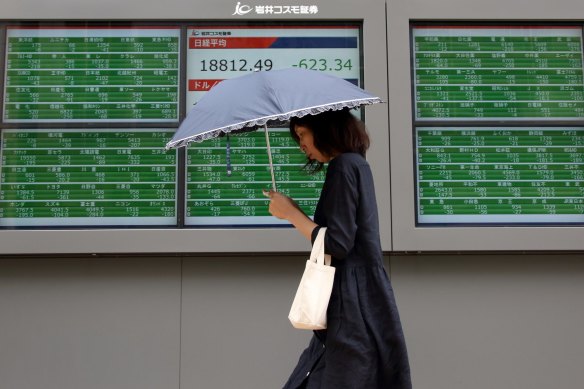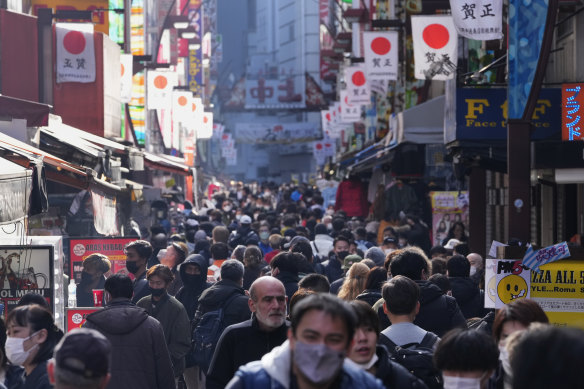Japan embarked on quantitative easing – purchasing government bonds to keep interest rates low – in 2001 and then, in 2016, implemented yield curve control by settings yield caps on particular maturities and targeting its purchases to police those caps. As a result of its policies it owns more than half all Japanese governments bonds on issue.
Until last December, the policies were achieving the desired results. Until then, 10-year government bonds had traded at yields around zero, below the 0.25 per cent cap the BoJ had set.

Japanese capital has been flowing out of the US, Europe and Australia and back to its domestic markets.Credit:Tomohiro Ohsumi
Late last year, however, bond investors drove yields on eight and nine-year securities to levels above the cap, distorting the yield curve and forcing the BoJ’s hand.
It raised the cap to 0.5 per cent and sent shockwaves through global markets, which have relied on Japan for ultra-cheap funding and devised trading strategies to profit from the stability of the ultra-low rates by borrowing in yen and then investing in higher-yielding assets elsewhere.
Japan is the world’s largest creditor nation, with more than $US3 trillion ($4.3 trillion) of net international investments. It exports capital to the rest of the world.
Loading
The prospect of increasing interest rates in Japan threatened the certainties of more than 20 years and triggered some reversal of the direction of capital flows as Japanese investors began repatriating their funds and hedge funds began unwinding their trades. Japanese capital has been flowing out of the US, Europe and Australia and back to its domestic markets.
The December decision to raise the yield cap triggered volatility in bond, equity and currency markets that was a foretaste of much greater turbulence and destabilisation to come if and when Japan abandons its unconventional policies.
Japan’s policies are increasingly divergent from those of the other major central banks. Indeed, they work at odds with the BoJ’s peers, with Japan and more recently China pumping liquidity into the global financial system even as the Federal Reserve and European Central bank are withdrawing it.
If Japan starts reducing the scope and scale of its unconventional strategies (which include buying, not just government bonds, but equity exposures to Japan’s larger companies) it will effectively be tightening global monetary conditions.
The task of leading the Boj through a period when delicate and potentially economy-changing (and legacy-defining) decisions will have to be made will now fall to Ueda.

The pandemic and then the war in Ukraine have driven up food and energy prices globally and Japan, without energy resources of its own, is particularly vulnerable.Credit:AP
It appears he plans to hasten slowly. In interviews last week he described the current BoJ policies as “”appropriate” and said that, for now, he thought it necessary to continuing the easing measures.
He also said last year, however, that the bank would need to review those measures at some point in future and that there was “a need for the BoJ to prepare an exit strategy.” It will now be up to him to devise that strategy.
A gradual exit from a yield curve control policy that is malfunctioning and appears past its use-by date would appear to be the priority.
The bank could initially lift and widen its target band but, if inflation becomes entrenched at its current level and the gap between Japan’s monetary policy and interest rate settings and those of the Federal Reserve and European Central Bank continue to increase, yield curve control will be increasingly anachronistic and damaging to the bank’s credibility, the effectiveness of its policies and its control over monetary settings.
Japan is the world’s largest creditor nation, with more than $US3 trillion of net international investments. It exports capital to the rest of the world.
Ultimately, he may need to chart a course towards a broader normalisation of Japan’s monetary policies, turning his back on the policies of the past two decades.
There is a qualification. While the current inflation rate is double the bank’s target of two per cent there are elements of that inflation which might be transitory.
The pandemic and then the war in Ukraine have driven up food and energy prices globally and Japan, without energy resources of its own, is particularly vulnerable. (That explains why the Japanese are so concerned about Australia’s government recent legislated intervention in our gas market, which could threaten LNG exports to Japan if gas contracted for export were to be forcibly redirected to the domestic market).
While there are signs of the much-longed-for wages growth emerging within Japan, they aren’t sufficiently widespread or entrenched for the BoJ to be confident that Japan won’t fall back into stagnation if food and energy inflation subsides.
Loading
That’s why an abrupt change to Japanese monetary policies is unlikely and why the consequences of any misjudgment are severe.
The BoJ either succeeds in establishing a smooth and predictable pathway to more conventional monetary policy settings or it fails, with deflation and recession-like conditions re-emerging in Japan and turmoil and trauma in global financial markets if the latter is the outcome.
Stay connected with us on social media platform for instant update click here to join our Twitter, & Facebook
We are now on Telegram. Click here to join our channel (@TechiUpdate) and stay updated with the latest Technology headlines.
For all the latest Business News Click Here
For the latest news and updates, follow us on Google News.
